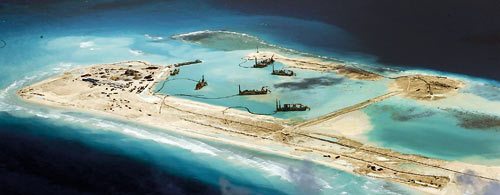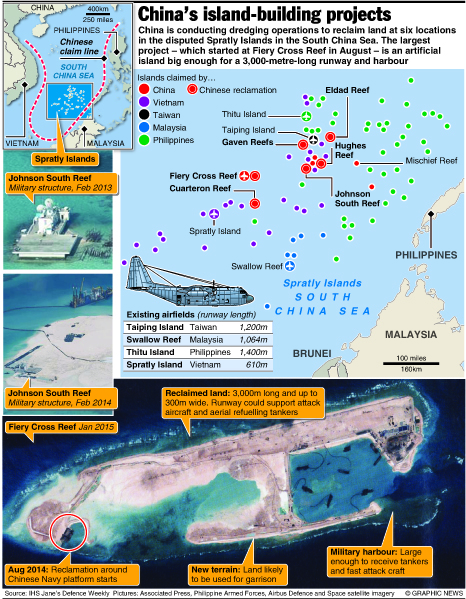Sunday Times 2
US Navy alarmed at Beijing’s ‘Great Wall of Sand’ in South China Sea

Between August and November in 2014, Chinese dredgers created a land mass on Fiery Cross that spans 3,000 metres long and 200 to 300 metres wide. (William Colson/CSIS)
BEIJING – China is building “a Great Wall of Sand” through an unparalleled programme of land reclamation in the South China Sea, raising concerns about the possibility of military confrontation in the disputed waters, according to the commander of the US Pacific Fleet.
In one of the strongest and highest level criticisms of the reclamation project to date, Adm. Harry Harris Jr. told a naval conference in Australia late Tuesday that competing territorial claims by several nations in the South China Sea continue to stoke “regional tensions and the potential for miscalculation.”
“But what’s really drawing a lot of concern in the here and now is the unprecedented land reclamation currently being conducted by China,” he said.
Satellite images show rapid construction on various coral reefs and rocks controlled by China within the disputed Spratly Islands, including harbours and piers, helipads, buildings and potentially at least one airstrip, experts say. Last month, State Department spokeswoman Jen Psaki expressed concerns that the programme was an attempt to “militarise outposts on disputed land features.”
Harris said China had now created 1.5 square miles of artificial landmass in recent months.
“China is building artificial land by pumping sand onto live coral reefs – some of them submerged – and paving them over with concrete,” he said. In a region known for its beautiful natural islands, he said, “China is creating a Great Wall of Sand with dredges and bulldozers over the course of months.”
China claims almost all of the South China Sea as its territorial waters, but its claims overlap with those of Vietnam, the Philippines, Taiwan, Malaysia and Brunei.
Last month, Foreign Minister Wang Yi said the country was merely carrying out “necessary construction on its own islands and reefs” and said it would continue to uphold freedom of navigation in the busy shipping waters of the South China Sea, as well as resolve disputes through “direct dialogue” and consultation.
 “The construction does not target or affect anyone,” he said at a news conference. “We do not accept criticism from others when we are merely building facilities in our own yard. We have every right to do things that are lawful and justified.”
“The construction does not target or affect anyone,” he said at a news conference. “We do not accept criticism from others when we are merely building facilities in our own yard. We have every right to do things that are lawful and justified.”
State news agency Xinhua was more forthright in rejecting US criticisms last month, accusing Washington of displaying a “perverted sense of insecurity” and a “pirate-style mindset.”
While China’s attention was focused elsewhere in previous decades, the other major claimants to the Spratly Islands occupied various islands and rocks throughout the archipelago, building ports, piers, bases and airstrips there. China now appears to be rushing to underline its own claims.
“This history matters a great deal, because what Washington and its friends and allies may see as punctuated, lightning-speed construction is likely viewed in China as a perfectly legitimate game of catch-up,” Mira Rapp-Hooper, director of the Asia Maritime Transparency Initiative and a fellow at the Centre for Strategic and International Studies (CSIS), wrote in a recent report.
“What sets China’s activities apart, however, is that Beijing has been dramatically changing the size and structure of existing physical land features, while other claimants have built upon or modified existing land masses,” she wrote in a related report.
The only major claimant without an airstrip in the archipelago, China appears to be turning the hitherto largely submerged Fiery Cross Reef into the largest island in the Spratlys, experts said.
Yanmei Xie, senior China analyst with the International Crisis Group in Beijing, said the island reclamation project was a deliberate strategic decision.
“Although China’s exact intention is unclear so far, they are likely mainly designed to extend China’s power projection, by expanding, for example, its surveillance, early warning and air interception capabilities further out into the sea,” she said. “With these added capabilities, China could have a de facto Air Defence Identification Zone in the South China Sea, even though it may not rush to declare one out of concern for the political and diplomatic fallout.”
China provoked strong US criticism when it unilaterally declared an Air Defence Identification Zone over disputed waters in the East China Sea in 2013, and Secretary of State John F. Kerry was among those who warned Beijing not to do the same over the South China Sea.
Harris said the pace of China’s construction of artificial islands “raises serious questions about Chinese intentions,” adding, “How China proceeds will be a key indicator of whether the region is heading toward confrontation or cooperation.”
Foreign policy experts said China’s activities would not reinforce its legal claims to the islands under the U.N. Convention on the Law of the Sea since only natural land features are relevant to maritime rights. But it could help China enforce de facto control of some of the disputed waters.
Chris Johnson, a senior adviser at CSIS, said China had carried out more reclamation work on the islands in the past five months than other claimants had done in the past five years. “They want to be able to operate with impunity in these waters, and they want the rest of us to accept it,” he said.
“So what does the game plan ultimately entail? Is it to be able to move around in these areas and operate, and by doing so, in a de facto manner, emphasise their claims? Or do they have intent, over time, to kick rival claimants off?” he asked. “I don’t think there’s a sense of that, but I do think their behaviour suggests they are moving in one direction, and they expect the other claimants to respect their growing power.”
(Liu Liu contributed to this report.) – Washington Post

